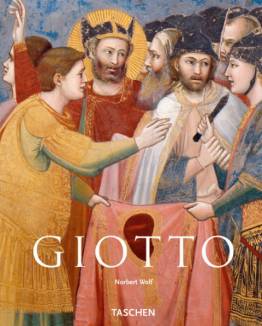|
|
|
Umschlagtext
www.taschen.com
Rezension
Die preisgünstige Reihe "Kleine Reihe Kunst" aus dem Kölner TASCHEN-Verlag bietet nicht nur über Kunstbewegungen und -genres einen kompakten Überblick über die künstlerischen Epochen von Romanik über Gotik und Renaissance zu Barock, Romantik, Impressionismus, Expressionismus bis in die Moderne, sondern auch zu einzelnen herausragenden Künstlern - wie hier zu Giotto, dem Erneuerer der Malerei und entscheidenden Wegbereiter der italienischen Renaissance. Als bedeutendste Aspekte seines Schaffens gelten die hohe Natürlichkeit und Lebhaftigkeit seiner Figuren, ebenso wie die Vorbereitung der Perspektive. Damit überwand er die ikonographischen Normen der byzantinischen Malerei. - In jedem Band werden die bedeutsamsten Kunstwerke des Künstlers präsentiert, vielfach mit ganz- oder doppelseitigem Bild: Im Preis-Leistungs-Verhältnis kaum zu übertreffen, zumal die Bild-Reproduktionen hervorragend sind. Abschließend findet sich eine Chronologie zum Künstler und seinem Werk.
Jens Walter, lehrerbibliothek.de Verlagsinfo
A central figure of the Early Renaissance According to legend, he was discovered by Cimabue as a boy, sketching his father`s sheep. Giotto di Bodone (1266-1337) was the most famous and influential painter of his generation in Italy. As the pioneer of modern painting, his impact was so enormous that his artist colleagues in Florence, however capable, were left struggling to keep up. His services were engaged by numerous high officials and princes, including the Pope and his cardinals, King Robert of Anjou, and the Scaligeri and Visconti. All these works, including the large secular cycles, are lost. Amongst his surviving works, his masterpieces are undoubtedly his decoration, from 1303 to 1305, of the private chapel built by the financier Enrico Scrovegni for his family in a former Roman amphitheatre in Padua, the fresco cycle in the Upper Church of Assisi, and the frescos in side chapels of Santa Croce in Florence. The simplicity and strength of his forms, as well as the humanism he infused in his works, set him apart from his Byzantine contemporaries and at the forefront of Italian painting in the early years of the Renaissance. About the Series: Every book in TASCHEN's Basic Art Series features: a detailed chronological summary of the artist's life and work, covering the cultural and historical importance of the artist approximately 100 color illustrations with explanatory captions a concise biography About the author: Norbert Wolf has published books on medieval art, Piranesi, Velázquez and Romantic painting, including TASCHEN’s Basic Art titles on Velàzquez, Kirchner, Friedrich and Holbein, and Codices Illustres: The World’s Most Famous Illuminated Manuscripts. He lives in Munich. Inhaltsverzeichnis
6
Geschichte und Geschichten 14 Spurensuche in Assisi 28 „Im Namen Gottes und des Geschäftes" 44 Der Wandel der Ikonen 60 „... zum Höchsten gelangt" 92 Chronologie Weitere Titel aus der Reihe Kleine Reihe Kunst |

 Bei Amazon kaufen
Bei Amazon kaufen